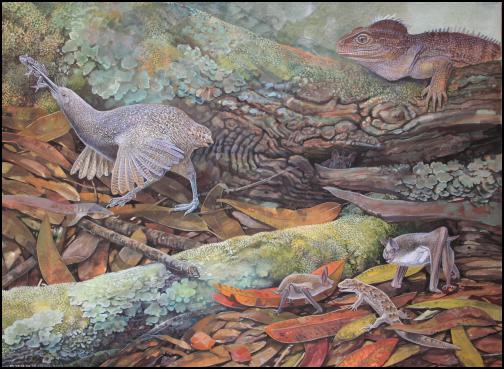Did small kiwi fly from Australia?

St Bathans Fauna. Illustration: Peter Schouton
Media Release
16 December 2013
Did small kiwi fly from Australia?
The kiwi, the iconic New Zealand flightless nocturnal bird, is not a dwarf version of a distant ancestor but more likely evolved from a tiny bird that could have flown from Australia, according to an Australian and New Zealand palaeontologists.
The findings of a study just published in the Proceedings of the 8th International Meeting of the Society of Avian Palaeontology and Evolution reveal the evolutionary pathway of the kiwi, overturning a commonly held theory championed by the late eminent evolutionary biologist Stephen Jay Gould.
Dr Trevor Worthy, of Flinders University in Adelaide, and a team from New Zealand’s Canterbury Museum and Te Papa Tongarewa The Museum of New Zealand discovered the fossil three years ago at St Bathans in New Zealand’s Central Otago.
Dr Worthy said the study results are supported by the genetic evidence that the kiwi is related to the Australian emu and not the New Zealand moa, an enormous emu-like bird that became extinct some 700 years ago.
“One of the distinguishing attributes of the kiwi is that it lays an enormous egg, which is about a quarter of the bird’s body weight and occupies most of the bird,” said Dr Worthy, an internationally-recognised expert on the moa.
“Gould’s 1986 essay, which sought to explain the origins of the kiwi egg’s size, promoted the idea that the kiwi was highly derived from a large moa-like ancestor, and had shrunk in size while retaining the egg size of this ancestor,” he said.
Dr Paul Scofield of Canterbury Museum said “This fossil from the early Miocene, about 20 million years ago, shows us that it’s a tiny bird about one third of the size of a small kiwi today. It suggests the opposite is, in fact, the case – that the kiwi has developed towards a larger size, a trend that is seen in many birds from the early Miocene.
“And if, as the DNA suggests, the kiwi is related to the emu, then both shared a common ancestor that could fly. It means they were little and had wings, and that they flew to New Zealand.”
Dr Worthy said it was not uncommon for birds to “jump” from Australia to New Zealand, citing the Mallard duck, the little banded dotterel and the cattle egret as three species which regularly fly back and forth.
“We need to find wing bones to put the theory beyond all doubt,” Dr Scofield said.
The researchers plan to continue excavations at St Bathans this summer. This research was funded by The Australian Research Council, The Mason Foundation and the R.S. Allan Fund.


 Great Journeys New Zealand: Scenic Plus Winter Menu Launched
Great Journeys New Zealand: Scenic Plus Winter Menu Launched Tourism New Zealand: Tourism New Zealand Invites The World To Find Their 100% Pure New Zealand In New Global Campaign
Tourism New Zealand: Tourism New Zealand Invites The World To Find Their 100% Pure New Zealand In New Global Campaign Bill Bennett: Comcom warns 2degrees over satellite marketing
Bill Bennett: Comcom warns 2degrees over satellite marketing Transpower: Major Electricity Development For Western Bay Of Plenty A Step Closer
Transpower: Major Electricity Development For Western Bay Of Plenty A Step Closer Alcohol Beverages Council: Turning The Tide - New Zealanders Unite To Curb Harmful Drinking
Alcohol Beverages Council: Turning The Tide - New Zealanders Unite To Curb Harmful Drinking University of Auckland Business School: Economists Urge Action To Prevent ‘AI Poverty Traps’
University of Auckland Business School: Economists Urge Action To Prevent ‘AI Poverty Traps’


